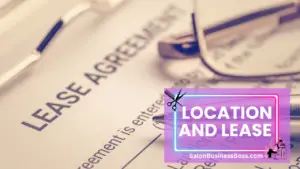Setting up a successful salon requires meticulous planning, a keen eye for detail, and a substantial financial investment. From selecting the ideal location to curating a captivating ambiance, numerous factors contribute to the overall setup costs.
Salon setup costs $100,000 to $500,000, encompassing essential elements like location, infrastructure, decor, services, marketing, permits, and insurance. A well-planned investment in skilled staff, quality products, and captivating ambiance ensures a successful and competitive salon venture in the beauty industry.
1. Location and Lease (10% to 25% of Total Cost):

Selecting the right location for your salon is undeniably one of the most crucial decisions you’ll make during the setup process. The location you choose will have a profound impact on the success and profitability of your business. A prime location can attract a steady flow of potential customers, while a less favorable one may hinder foot traffic and limit your client base.
Visibility is key to drawing in potential clients. A salon situated in a high-traffic area with good visibility from the street is more likely to catch the attention of passersby, increasing the chances of walk-in customers. Additionally, being easily accessible by public transport or major roads can further enhance your salon’s appeal.
The cost of leasing or purchasing a suitable space can vary significantly based on several factors. Areas with high population densities, affluent neighborhoods, or bustling commercial centers may command higher rents due to increased demand. Conversely, less densely populated or economically challenged areas might offer more affordable options. As a rule of thumb, allocating 10% to 25% of your total setup costs towards the location expense is a reasonable estimate.
Conducting thorough research on the demographics, local economy, and real estate market trends of potential locations is essential. Careful consideration of these factors will help you make an informed decision, striking a balance between costs and potential returns on investment. Ultimately, finding the right location will set a strong foundation for your salon’s success and growth in the beauty and wellness industry.
Read more about: Empowering Your Brand: Haircare Product Marketing
2. Salon Infrastructure (20% to 35% of Total Cost):
Designing an inviting and functional space is vital to the success of any salon. To achieve this, careful attention must be paid to the salon’s infrastructure. Renovating the premises is often necessary to create an environment that caters to both the clients’ needs and the stylists’ workflow. The layout should be optimized to accommodate salon stations, sinks, and storage areas while ensuring ample space for customers to move comfortably.
Plumbing is a critical aspect, as it enables the salon to offer a variety of services such as hair washing and coloring. Properly installed plumbing ensures efficiency and avoids inconvenience to both staff and clients. Similarly, electrical fixtures must be strategically positioned to accommodate salon equipment, lighting, and power outlets for various electrical tools.
Proper ventilation is essential to maintain a comfortable and fresh atmosphere within the salon. Adequate ventilation not only helps eliminate odors and fumes from hair treatments but also contributes to a pleasant experience for clients and employees alike.
Investing in top-quality salon equipment is another crucial element of creating an appealing space. Salon chairs should be comfortable and durable, providing clients with a relaxing experience. High-performance hairdryers and shampoo units are essential for efficient service delivery. Additionally, a well-designed reception desk can enhance the salon’s professionalism and leave a lasting impression on clients.
The cost of these infrastructure components, including renovations and equipment, typically accounts for 20% to 35% of the overall budget. While it may seem like a substantial investment, allocating adequate funds to create a functional and aesthetically pleasing salon environment is a wise long-term strategy. A well-designed space not only attracts and retains clients but also fosters a positive working environment for stylists, contributing to the overall success and reputation of the salon.
3. Salon Décor and Ambiance (15% to 30% of Total Cost):
The ambiance of a salon is a critical factor that can make or break the client’s overall experience. Creating an inviting and visually appealing interior is essential for attracting and retaining clients. A well-designed ambiance not only sets the tone for the salon’s brand but also influences the mood and emotions of the clients during their visit.
Stylish furnishings, carefully chosen to align with the salon’s theme and target audience, can elevate the overall atmosphere. Comfortable seating and well-placed mirrors contribute to the clients’ comfort and satisfaction during their time at the salon. Additionally, investing in high-quality furnishings ensures durability, reducing long-term replacement costs.
Color schemes play a significant role in setting the salon’s ambiance. Calming and soothing colors can create a relaxed environment, while vibrant and energetic tones can infuse a sense of liveliness. The right color palette complements the salon’s brand identity and enhances the overall aesthetic appeal.
Ambient lighting is another crucial element that impacts the ambiance. Soft and warm lighting can create a cozy and intimate atmosphere, while brighter lighting is essential for precise styling work. A combination of natural and artificial lighting can strike the right balance and highlight specific features of the salon.
While investing in decor and ambiance is essential, it’s essential to strike a balance between cost and quality. Allocating around 15% to 30% of the total setup expenses to decor and ambiance is a reasonable estimate. This investment pays off by leaving a lasting impression on clients, encouraging them to return and recommend the salon to others.
4. Salon Services and Product Inventory (25% to 40% of Total Cost):
A successful salon relies heavily on its staff and the quality of products it offers. To provide clients with a comprehensive range of services, hiring skilled and experienced professionals is paramount. Talented stylists and beauticians bring creativity, expertise, and a personalized touch to every client interaction, elevating the overall salon experience. Equally important is recruiting competent support staff to manage appointments, customer inquiries, and salon operations efficiently.
Allocating a substantial portion of the setup budget, typically around 25% to 40%, towards staffing costs is a prudent investment in the salon’s future success. Well-compensated and content employees tend to exhibit higher levels of motivation, leading to improved customer satisfaction and client retention.
Offering top-quality hair care, skincare, and beauty products is fundamental to a salon’s reputation. A diverse inventory of reputable brands and premium products caters to various client needs and preferences. Clients appreciate being offered an array of options that address their unique hair and skin requirements.
While investing in skilled staff and quality products may seem cost-intensive, it is a necessary expense to ensure the salon’s long-term success. Satisfied clients are more likely to become loyal customers and act as brand ambassadors, promoting the salon through word-of-mouth referrals.
5. Marketing and Branding (5% to 10% of Total Cost):

In a highly competitive market, effective marketing and branding are indispensable for a salon’s success. Allocating a budget for strategic marketing initiatives is essential to attract and retain clients. Investing in online and offline marketing campaigns helps reach a broader audience and create brand awareness.
A portion of the total setup investment, usually around 5% to 10%, should be earmarked for marketing endeavors. This budget can be allocated to various marketing channels, such as digital advertising, print materials, and promotional events. Online marketing plays a pivotal role in today’s digital age, and having a well-designed website is a must. It serves as the salon’s virtual storefront and a platform to showcase services, prices, and testimonials, thus enticing potential clients.
A robust social media presence is equally crucial. Social media platforms provide an opportunity to engage with clients, share before-and-after transformations, and promote special offers. This interactive approach fosters a sense of community and builds trust with potential clients.
Professional branding materials, including logos, business cards, and brochures, contribute to the salon’s identity and brand recognition. Cohesive and visually appealing branding enhances the salon’s credibility and distinguishes it from competitors.
Participating in local events, collaborating with influencers, or offering promotional deals can attract initial clientele and generate word-of-mouth referrals.
Read more about: Building Your Salon: What the Numbers Say
6. Licensing, Permits, and Legal Fees (3% to 8% of Total Cost):
Complying with local regulations and obtaining the required licenses and permits is a fundamental aspect of establishing a salon. As a beauty and wellness business, salons must adhere to various health and safety standards to ensure the well-being of their clients and staff. This may involve obtaining health department permits, fire safety clearances, and sanitation licenses, among others. Each region or municipality may have specific requirements, making it essential for salon owners to research and understand the local regulations thoroughly.
Obtaining the necessary business licenses is another critical step. This includes registering the salon as a legal entity, securing a tax identification number, and fulfilling any local business registration obligations. Failure to acquire the proper licenses can result in penalties or even forced closure of the salon.
In certain cases, specialized certifications might be required, especially for services involving chemicals or specialized equipment. Acquiring these certifications demonstrates the salon’s commitment to safety and professionalism.
Legal fees and consultation charges are likely to be incurred during the process of navigating the complex regulatory landscape. Seeking legal advice ensures that all the necessary permits and licenses are obtained correctly and can protect the salon from potential legal disputes.
Setting aside around 3% to 8% of the total setup expenses for licensing, permits, and legal fees is a prudent estimate. While this might seem like an additional financial burden, it is a necessary investment to ensure the salon’s legitimacy, compliance, and smooth operations in the long run.
7. Insurance Coverage (2% to 5% of Total Cost):
Ensuring the protection of your salon and its assets is a critical aspect of running a business. Acquiring comprehensive insurance coverage safeguards against unforeseen risks and potential liabilities. There are three main types of insurance that every salon owner should consider: liability insurance, property insurance, and worker’s compensation insurance.
Liability insurance is crucial for protecting the salon from legal claims and financial losses arising from accidents or injuries that may occur on the premises. This coverage helps cover legal fees, medical expenses, and potential settlements, providing peace of mind to both the salon owner and its clients.
Property insurance protects the physical assets of the salon, including the building, equipment, furniture, and inventory, against perils like fire, theft, vandalism, or natural disasters. In the event of a covered loss, property insurance helps in recovering the costs of repairing or replacing damaged property.
Worker’s compensation insurance is essential for salons with employees. It provides benefits to employees who suffer work-related injuries or illnesses. Having worker’s compensation coverage ensures that employees receive medical treatment and wage replacement, while also protecting the salon from potential lawsuits arising from workplace accidents.
While insurance is a crucial safeguard, it is vital to budget for it properly. Allocating approximately 2% to 5% of the total setup costs for insurance coverage is a reasonable estimate. The cost may vary depending on the size of the salon, the number of employees, and the insurance company’s rates.
Conclusion
Setting up a salon involves substantial financial investment, with costs ranging from $100,000 to $500,000, depending on various factors. From securing the perfect location to creating an inviting ambiance, investing in top-quality infrastructure, hiring skilled staff, and implementing effective marketing strategies, every aspect contributes to the overall expenditure. By conducting meticulous research, creating a detailed business plan, and exploring cost-effective options, salon owners can optimize their spending while ensuring a successful and flourishing venture in the beauty and wellness industry.
Frequently Asked Questions

1. Can I save on setup costs by purchasing second-hand equipment?
Yes, purchasing some second-hand equipment can help save costs, but prioritize quality and safety to avoid long-term issues.
2. How can I optimize expenses without compromising quality?
Focus on cost-effective marketing strategies, negotiate with suppliers, and invest in quality staff and products to optimize expenses while maintaining high standards.
3. What are some potential hidden costs I should be aware of?
Hidden costs may include unexpected repairs, utility deposits, or permit processing fees, so allocate a contingency fund in your budget.
To learn more on how to start you own salon checkout my startup documents here.
Please note that the contents of this blog are for informational and entertainment purposes only and should not be construed as legal advice. Any action taken based on the information provided in this blog is solely at your own risk. Additionally, all images used in this blog are generated under the CC0 license of Creative Commons, which means they are free to use for any purpose without attribution.

About the author. Entrepreneur and Salon Business Fan.
Hi! I am Shawn and I am a happy individual who happens to be an entrepreneur. I have owned several types of businesses in my life from a coffee shop to an import and export business to an online review business plus a few more and now I create online salon business resources for those interested in starting new ventures. It’s demanding work but I love it. I do it for those passionate about their business and their goals. That’s why when I meet a salon business owner, I see myself. I know how hard the struggle is to retain clients, find good employees and keep the business growing all while trying to stay competitive.
That’s why I created Salon Business Boss: I want to help salon business owners like you build a thriving business that brings you endless joy and supports your ideal lifestyle.


